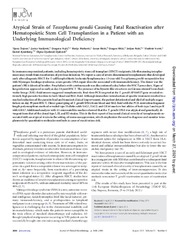Приказ основних података о документу
Atypical Strain of Toxoplasma gondii Causing Fatal Reactivation after Hematopoietic Stem Cell Transplantion in a Patient with an Underlying Immunological Deficiency
| dc.creator | Štajner, Tijana | |
| dc.creator | Vasiljević, Zorica | |
| dc.creator | Vujić, Dragana | |
| dc.creator | Marković, Marija | |
| dc.creator | Ristić, Goran | |
| dc.creator | Micić, Dragan | |
| dc.creator | Pasić, Srđan | |
| dc.creator | Ivović, Vladimir | |
| dc.creator | Ajzenberg, Daniel | |
| dc.creator | Đurković-Đaković, Olgica | |
| dc.date.accessioned | 2021-04-20T12:31:56Z | |
| dc.date.available | 2021-04-20T12:31:56Z | |
| dc.date.issued | 2013 | |
| dc.identifier.issn | 0095-1137 | |
| dc.identifier.uri | http://rimi.imi.bg.ac.rs/handle/123456789/456 | |
| dc.description.abstract | In immunocompromized patients, including hematopoietic stem cell transplant (HSCT) recipients, life-threatening toxoplasmosis may result from reactivation of previous infection. We report a case of severe disseminated toxoplasmosis that developed early after allogeneic HSCT for T-cell lymphoblastic leukemia/lymphoma in a 15-year-old Toxoplasma gondii-seropositive boy with Nijmegen breakage syndrome, a rare genetic DNA repair disorder associated with immunodeficiency. The donor was the patient's HLA-identical brother. Prophylaxis with cotrimoxazole was discontinued a day before the HSCT procedure. Signs of lung infection appeared as early as day 14 post-HSCT. The presence of tachyzoite-like structures on Giemsa-stained bronchoalveolar lavage (BAL) fluid smears suggested toxoplasmosis. Real-time PCR targeted at the T. gondii AF146527 gene revealed extremely high parasite burdens in both blood and BAL fluid. Although immediate introduction of specific treatment resulted in a marked reduction of the parasite load and transient clinical improvement, the patient deteriorated and died of multiple organ failure on day 39 post-HSCT. Direct genotyping of T. gondii DNA from blood and BAL fluid with the PCR-restriction fragment length polymorphism method revealed type II alleles with SAG1, SAG2, and GRA6 markers but alleles of both type I and type II with GRA7. Additional analysis with 15 microsatellite markers showed that the T. gondii DNA was atypical and genetically divergent from that of the clonal type I, II, and III strains. This is the first report of increased clinical severity of toxoplasmosis associated with an atypical strain in the setting of immunosuppression, which emphasizes the need to diagnose and monitor toxoplasmosis by quantitative molecular methods in cases of reactivation risk. | en |
| dc.publisher | Amer Soc Microbiology, Washington | |
| dc.relation | info:eu-repo/grantAgreement/MESTD/Integrated and Interdisciplinary Research (IIR or III)/41019/RS// | |
| dc.rights | openAccess | |
| dc.source | Journal of Clinical Microbiology | |
| dc.title | Atypical Strain of Toxoplasma gondii Causing Fatal Reactivation after Hematopoietic Stem Cell Transplantion in a Patient with an Underlying Immunological Deficiency | en |
| dc.type | article | |
| dc.rights.license | ARR | |
| dc.citation.epage | 2690 | |
| dc.citation.issue | 8 | |
| dc.citation.other | 51(8): 2686-2690 | |
| dc.citation.rank | M21 | |
| dc.citation.spage | 2686 | |
| dc.citation.volume | 51 | |
| dc.identifier.doi | 10.1128/JCM.01077-13 | |
| dc.identifier.fulltext | http://rimi.imi.bg.ac.rs/bitstream/id/346/453.pdf | |
| dc.identifier.pmid | 23761151 | |
| dc.identifier.scopus | 2-s2.0-84880644407 | |
| dc.identifier.wos | 000321951800030 | |
| dc.type.version | publishedVersion |

